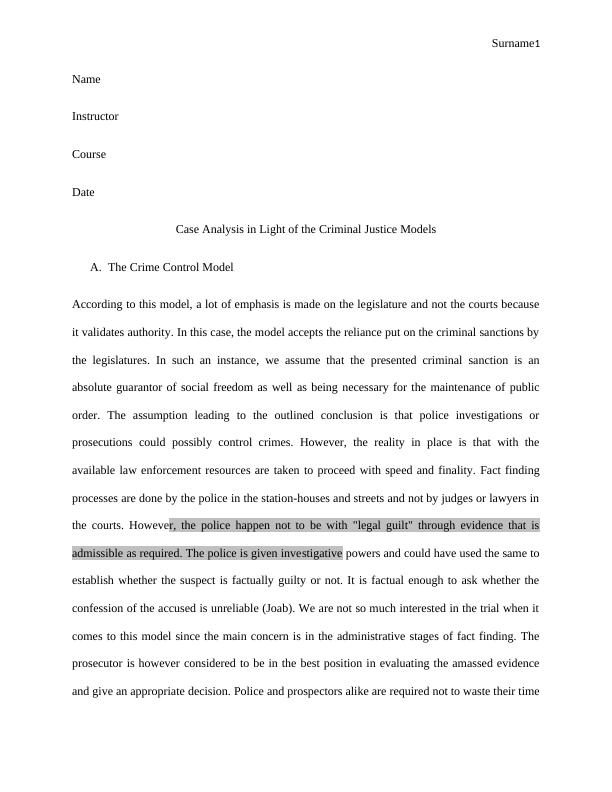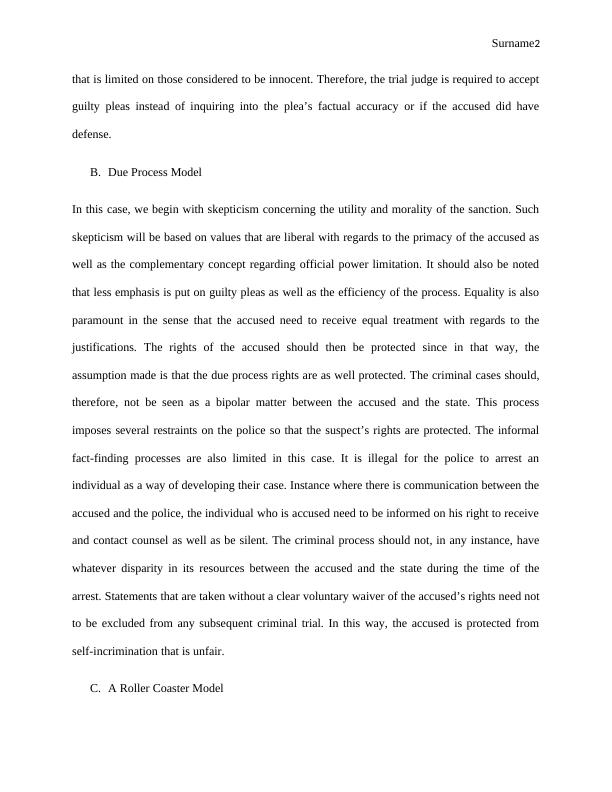Case Analysis in Light of the Criminal Justice
Added on 2020-04-15
5 Pages1158 Words68 Views
Surname1NameInstructorCourseDateCase Analysis in Light of the Criminal Justice ModelsA.The Crime Control ModelAccording to this model, a lot of emphasis is made on the legislature and not the courts becauseit validates authority. In this case, the model accepts the reliance put on the criminal sanctions bythe legislatures. In such an instance, we assume that the presented criminal sanction is anabsolute guarantor of social freedom as well as being necessary for the maintenance of publicorder. The assumption leading to the outlined conclusion is that police investigations orprosecutions could possibly control crimes. However, the reality in place is that with theavailable law enforcement resources are taken to proceed with speed and finality. Fact findingprocesses are done by the police in the station-houses and streets and not by judges or lawyers inthe courts. However, the police happen not to be with "legal guilt" through evidence that isadmissible as required. The police is given investigative powers and could have used the same toestablish whether the suspect is factually guilty or not. It is factual enough to ask whether theconfession of the accused is unreliable (Joab). We are not so much interested in the trial when itcomes to this model since the main concern is in the administrative stages of fact finding. Theprosecutor is however considered to be in the best position in evaluating the amassed evidenceand give an appropriate decision. Police and prospectors alike are required not to waste their time

Surname2that is limited on those considered to be innocent. Therefore, the trial judge is required to acceptguilty pleas instead of inquiring into the plea’s factual accuracy or if the accused did havedefense. B.Due Process ModelIn this case, we begin with skepticism concerning the utility and morality of the sanction. Suchskepticism will be based on values that are liberal with regards to the primacy of the accused aswell as the complementary concept regarding official power limitation. It should also be notedthat less emphasis is put on guilty pleas as well as the efficiency of the process. Equality is alsoparamount in the sense that the accused need to receive equal treatment with regards to thejustifications. The rights of the accused should then be protected since in that way, theassumption made is that the due process rights are as well protected. The criminal cases should,therefore, not be seen as a bipolar matter between the accused and the state. This processimposes several restraints on the police so that the suspect’s rights are protected. The informalfact-finding processes are also limited in this case. It is illegal for the police to arrest anindividual as a way of developing their case. Instance where there is communication between theaccused and the police, the individual who is accused need to be informed on his right to receiveand contact counsel as well as be silent. The criminal process should not, in any instance, havewhatever disparity in its resources between the accused and the state during the time of thearrest. Statements that are taken without a clear voluntary waiver of the accused’s rights need notto be excluded from any subsequent criminal trial. In this way, the accused is protected fromself-incrimination that is unfair.C.A Roller Coaster Model

End of preview
Want to access all the pages? Upload your documents or become a member.
Related Documents
Criminal Litigation: Offence, Sentences, Allocation, Advantages, Legal Aid, Plea in Mitigationlg...
|9
|2575
|157
Criminal Law Assignment 2022lg...
|8
|1764
|28
Criminal Justice Final Reportlg...
|7
|1454
|85
Criminal Procedure: John Doe's Caselg...
|6
|992
|262
Law and Legal System: Main Stages, Stakeholders, and Effectivenesslg...
|7
|2051
|83
Criminal Justice Case Analysislg...
|6
|1511
|53
